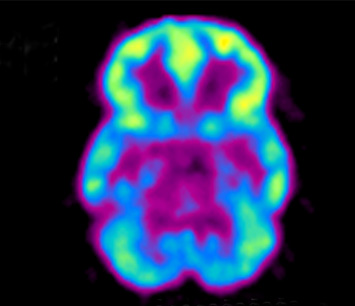MEDIA ADVISORY: Lab Honored for Developing Tracer for Brain Imaging and Cancer Diagnosis
BNL Chemistry Building named Historic Chemical Landmark by NY Section of ACS
October 15, 2012
EVENT: The New York Section of the American Chemical Society (ACS) will designate the Chemistry Building at the U.S. Department of Energy’s Brookhaven National Laboratory as an Historical Chemical Landmark, in recognition of the synthesis of 18FDG, the first successful radiotracer for positron emission tomography (PET) imaging, now used world wide.
WHEN: Friday, October 19, 2012, Ceremony - 9 a.m., Scientific Presentations - 10 a.m.
WHERE: Brookhaven National Laboratory, Building 555. The Laboratory is located 1.5 miles north of the Long Island Expressway, exit 68, on William Floyd Parkway.
DETAILS: 18FDG is chemistry shorthand for “2-deoxy-2-[18F]fluoro-D-glucose,” which is now the standard radiotracer used for positron emission tomography (PET) neuroimaging and cancer diagnosis. More than 1.5 million 18FDG PET scans are performed annually around the world. This chemical was first synthesized by chemists at Brookhaven Lab in 1976, and quickly transported to the University of Pennsylvania, where collaborators first demonstrated its use in brain imaging.
The chemical name hints at how 18FDG works: It serves as a stand-in for glucose, the body’s main source of energy, traveling to tissues where glucose is needed. While there, the short-lived radioactive isotope of fluorine, 18F, emits particles called positrons, which send off energetic back-to-back gamma rays when they interact with the body’s electrons. Those signals, picked up by a PET scanner, produce maps of metabolic activity in the brain and body. At this event, you’ll hear more about the history of 18FDG, the challenges of its development, and how it has revolutionized neuroscience—including the study of drug addiction—as well as cancer diagnosis and management.
CEREMONY and refreshments: 9-10 a.m.
Speakers will include representatives of Brookhaven Lab management, the Chemistry Department, the New York Section of the American Chemical Society, Stony Brook University, the Department of Energy, and other dignitaries.
SCIENTIFIC PRESENTATIONS: 10 a.m. – 12:30 p.m.
- Louis Sokoloff, M.D., Laboratory of Cerebral Metabolism, National Institute of Mental Health: Development of the 18FDG Method: A Serendipitous Journey from Bench to Bedside (by video)
- Joanna S. Fowler, Ph.D., Head of Radiotracer Development, Brookhaven National Laboratory, and Tatsuo Ido, Ph.D., Visiting Professor, Fukui University, Professor Emeritus, Tohoku University: Working Against Time: 18FDG and Chemistry
- Abass Alavi, M.D., Chief, Division of Nuclear Medicine, University of Pennsylvania: Unparalleled Contributions of FDG-PET to Medicine
- Mony J. DeLeon, Ed.D., Department of Psychiatry, New York University Medical Center: Alzheimer's disease
- Nora D. Volkow, M.D., Director, National Institute on Drug Abuse: FDG: Contribution to Our Understanding of Addiction
PRESS REGISTRATION: Reporters interested in attending, please contact Karen McNulty Walsh, Brookhaven Lab Media & Communications Office, 631 344-8350, kmcnulty@bnl.gov.
2012-11460 | INT/EXT | Newsroom










